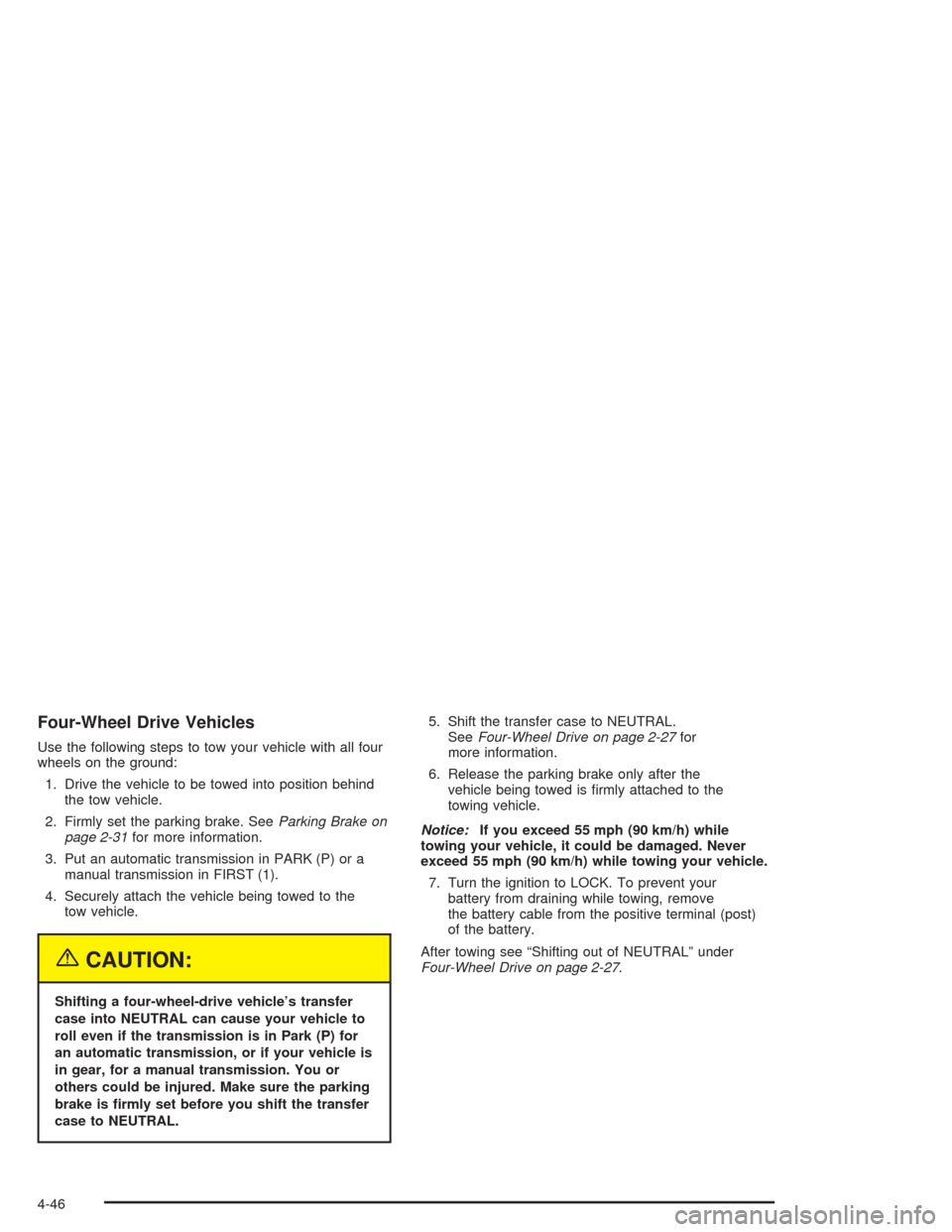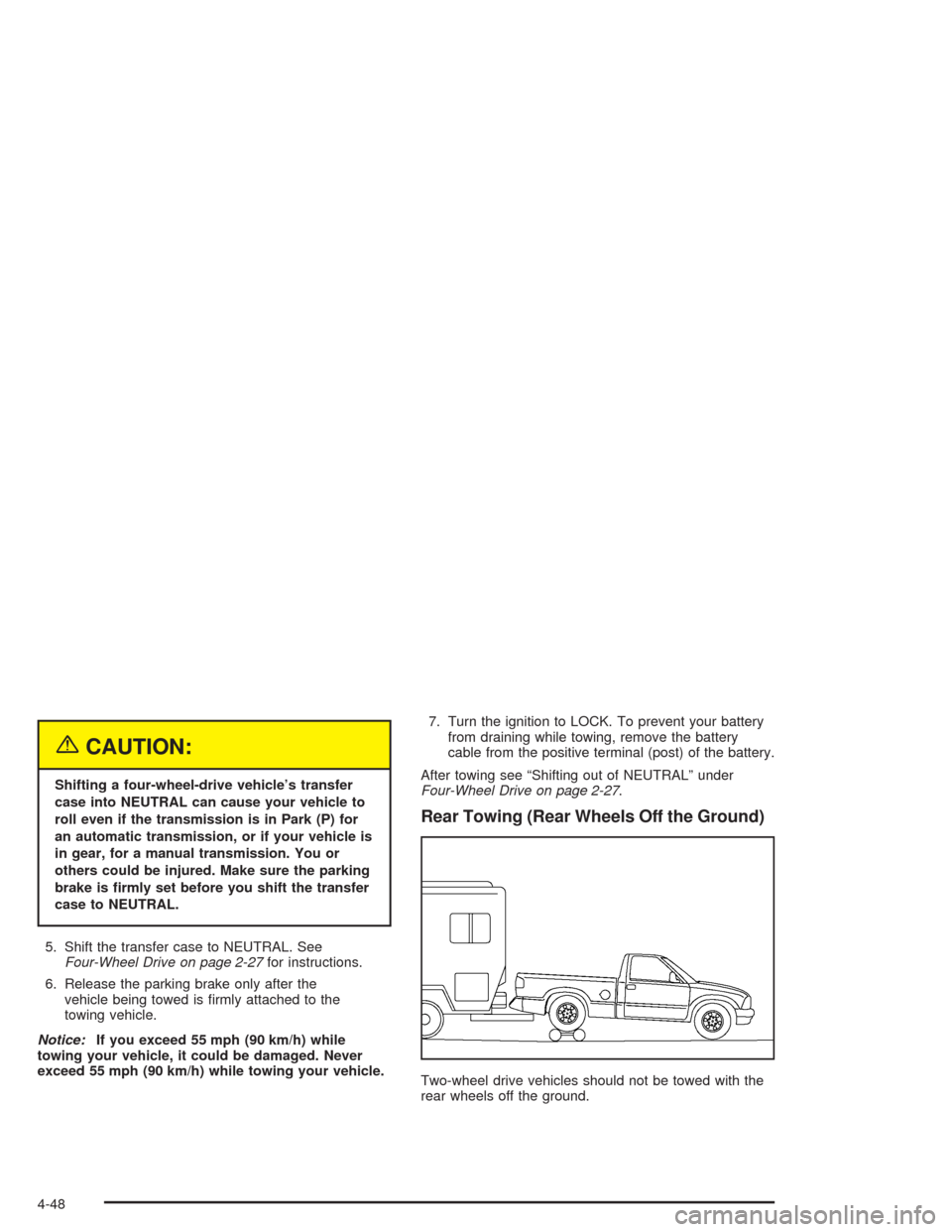Page 234 of 414

Four-Wheel Drive Vehicles
Use the following steps to tow your vehicle with all four
wheels on the ground:
1. Drive the vehicle to be towed into position behind
the tow vehicle.
2. Firmly set the parking brake. SeeParking Brake on
page 2-31for more information.
3. Put an automatic transmission in PARK (P) or a
manual transmission in FIRST (1).
4. Securely attach the vehicle being towed to the
tow vehicle.
{CAUTION:
Shifting a four-wheel-drive vehicle’s transfer
case into NEUTRAL can cause your vehicle to
roll even if the transmission is in Park (P) for
an automatic transmission, or if your vehicle is
in gear, for a manual transmission. You or
others could be injured. Make sure the parking
brake is �rmly set before you shift the transfer
case to NEUTRAL.5. Shift the transfer case to NEUTRAL.
SeeFour-Wheel Drive on page 2-27for
more information.
6. Release the parking brake only after the
vehicle being towed is �rmly attached to the
towing vehicle.
Notice:If you exceed 55 mph (90 km/h) while
towing your vehicle, it could be damaged. Never
exceed 55 mph (90 km/h) while towing your vehicle.
7. Turn the ignition to LOCK. To prevent your
battery from draining while towing, remove
the battery cable from the positive terminal (post)
of the battery.
After towing see “Shifting out of NEUTRAL” under
Four-Wheel Drive on page 2-27.
4-46
Page 235 of 414
Dolly Towing
Two-Wheel-Drive Vehicles
Two-wheel drive vehicles should not be towed with
the rear wheels on the ground. Two-wheel drive
transmissions have no provisions for internal lubrication
while being towed.
Four-Wheel-Drive Vehicles
Front Towing (Front Wheels Off the Ground)
Use the following steps to dolly tow your vehicle from
the front:
1. Drive the vehicle up onto the dolly.
2. Firmly set the parking brake. SeeParking Brake
on page 2-31for more information.
3. Put an automatic transmission in PARK (P) or a
manual transmission in FIRST (1).
4. Follow the dolly manufacturer’s instructions to
attach and secure the vehicle being towed to
the dolly and then the loaded dolly to the
tow vehicle.
4-47
Page 236 of 414

{CAUTION:
Shifting a four-wheel-drive vehicle’s transfer
case into NEUTRAL can cause your vehicle to
roll even if the transmission is in Park (P) for
an automatic transmission, or if your vehicle is
in gear, for a manual transmission. You or
others could be injured. Make sure the parking
brake is �rmly set before you shift the transfer
case to NEUTRAL.
5. Shift the transfer case to NEUTRAL. See
Four-Wheel Drive on page 2-27for instructions.
6. Release the parking brake only after the
vehicle being towed is �rmly attached to the
towing vehicle.
Notice:If you exceed 55 mph (90 km/h) while
towing your vehicle, it could be damaged. Never
exceed 55 mph (90 km/h) while towing your vehicle.7. Turn the ignition to LOCK. To prevent your battery
from draining while towing, remove the battery
cable from the positive terminal (post) of the battery.
After towing see “Shifting out of NEUTRAL” under
Four-Wheel Drive on page 2-27.
Rear Towing (Rear Wheels Off the Ground)
Two-wheel drive vehicles should not be towed with the
rear wheels off the ground.
4-48
Page 237 of 414

Four-Wheel-Drive Vehicles
Use the following steps to dolly tow your vehicle from
the rear:
1. Drive the vehicle up onto the dolly.
2. Firmly set the parking brake. SeeParking Brake on
page 2-31for more information.
3. Put an automatic transmission in PARK (P) or a
manual transmission in FIRST (1).
4. Follow the dolly manufacturer’s instructions to
attach and secure the vehicle being towed to
the dolly and then the loaded dolly to the
tow vehicle.
{CAUTION:
Shifting a four-wheel-drive vehicle’s transfer
case into NEUTRAL can cause your vehicle to
roll even if the transmission is in Park (P) for
an automatic transmission, or if your vehicle is
in gear, for a manual transmission. You or
others could be injured. Make sure the parking
brake is �rmly set before you shift the transfer
case to NEUTRAL.5. Shift the transfer case to 2HI. SeeFour-Wheel
Drive on page 2-27for instructions.
6. Release the parking brake only after the vehicle
being towed is �rmly attached to the
towing vehicle.
Notice:If you exceed 55 mph (90 km/h) while
towing your vehicle, it could be damaged. Never
exceed 55 mph (90 km/h) while towing your vehicle.
7. Turn the ignition to LOCK. To prevent your
battery from draining while towing, remove the
battery cable from the positive terminal (post) of
the battery.
After towing see “Shifting out of NEUTRAL” under
Four-Wheel Drive on page 2-27.
4-49
Page 246 of 414

If You Do Decide To Pull A Trailer
If you do, here are some important points:
There are many different laws, including speed limit
restrictions, having to do with trailering. Make sure
your rig will be legal, not only where you live
but also where you’ll be driving. A good source for
this information can be state or provincial police.
Consider using a sway control. You can ask a hitch
dealer about sway controls.
Don’t tow a trailer at all during the �rst
500 miles (800 km) your new vehicle is driven.
Your engine, axle or other parts could be damaged.
Then, during the �rst 500 miles (800 km) that
you tow a trailer, don’t drive over 50 mph (80 km/h)
and don’t make starts at full throttle. This helps
your engine and other parts of your vehicle wear in
at the heavier loads.
You may want to shift the transmission to THIRD (3)
or, if necessary, a lower gear selection if the
transmission shifts too often (e.g., under heavy
loads and/or hilly conditions). If you have a manual
transmission and you are towing a trailer, it’s
better not to use the highest gear.Three important considerations have to do with weight:
the weight of the trailer,
the weight of the trailer tongue
and the weight on your vehicle’s tires.
Weight of the Trailer
How heavy can a trailer safely be?
It depends on how you plan to use your rig. For
example, speed, altitude, road grades, outside
temperature and how much your vehicle is used to pull
a trailer are all important. And, it can also depend
on any special equipment that you have on your vehicle.
The following chart shows how much your trailer can
weigh, based upon your vehicle model and options.
Maximum trailer weight is calculated assuming only the
driver is in the tow vehicle and it has all the required
trailering equipment. The weight of additional optional
equipment, passengers and cargo in the tow vehicle
must be subtracted from the maximum trailer weight.
The weight of the trailer tongue also affects trailering
capacity. See “Weight of the Trailer Tongue” next.
4-58
Page 247 of 414
Vehicle Axle Ratio Maximum Trailer Weight GCWR**
2WD Regular Cab
Automatic Transmission,
2.8 L Engine3.73 3,500 lbs. (1 587 kg) 7,000 lbs. (3 175 kg)
Automatic Transmission,
3.5 L Engine3.42 4,000 lbs. (1 814 kg) 8,500 lbs. (3 856 kg)
Automatic Transmission,
3.5 L Engine3.73 4,000 lbs. (1 814 kg) 8,500 lbs. (3 855 kg)
Manual Transmission,
2.8 L Engine3.42 2,000 lbs. (907 kg) 5,500 lbs. (2 495 kg)
Manual Transmission,
2.8 L Engine3.73 2,500 lbs. (1 133 kg) 6,000 lbs. (2 722 kg)
Manual Transmission,
3.5 L Engine3.42 3,500 lbs. (1 587 kg) 7,000 lbs. (3 175 kg)
Manual Transmission,
3.5 L Engine3.73 3,900 lbs. (1 769 kg) 7,500 lbs. (3 402 kg)
Vehicle Axle Ratio Maximum Trailer Weight GCWR**
2WD Extended Cab
Automatic Transmission,
2.8 L Engine3.73 3,200 lbs. (1 451 kg) 7,000 lbs. (3 175 kg)
Automatic Transmission,
3.5 L Engine3.42 4,000 lbs. (1 814 kg) 8,500 lbs. (3 856 kg)
Automatic Transmission,
3.5 L Engine3.73 4,000 lbs. (1 814 kg) 9,000 lbs. (4 082 kg)
4-59
Page 248 of 414
Vehicle Axle Ratio Maximum Trailer Weight GCWR**
Manual Transmission,
2.8 L Engine3.42 1,700 lbs. (771 kg) 5,500 lbs. (2 495 kg)
Manual Transmission,
2.8 L Engine3.73 2,200 lbs. (997 kg) 6,000 lbs. (2 722 kg)
Manual Transmission,
3.5 L Engine3.42 3,200 lbs. (1 451 kg) 7,000 lbs. (3 175 kg)
Manual Transmission,
3.5 L Engine3.73 3,600 lbs. (1 633 kg) 7,500 lbs. (3 402 kg)
Vehicle Axle Ratio Maximum Trailer Weight GCWR**
2WD Crew Cab
Automatic Transmission,
2.8 L Engine3.73 3,100 lbs. (1 406 kg) 7,000 lbs. (3 175 kg)
Automatic Transmission,
3.5 L Engine3.42 4,000 lbs. (1 814 kg) 8,500 lbs. (3 856 kg)
Automatic Transmission,
3.5 L Engine3.73 4,000 lbs. (1 814 kg) 9,000 lbs. (4 082 kg)
Manual Transmission,
2.8 L Engine3.42 1,600 lbs. (725 kg) 5,500 lbs. (2 495 kg)
Manual Transmission,
2.8 L Engine3.73 2,100 lbs. (952 kg) 6,000 lbs (2 722 kg)
4-60
Page 249 of 414
Vehicle Axle Ratio Maximum Trailer Weight GCWR**
4WD Regular Cab
Automatic Transmission,
2.8 L Engine3.73 3,100 lbs. (1 406 kg) 7,000 lbs. (3 175 kg)
Automatic Transmission,
2.8 L Engine4.10 3,100 lbs. (1 406 kg) 7,000 lbs. (3 175 kg)
Automatic Transmission,
3.5 L Engine3.42 4,000 lbs. (1 814 kg) 8,500 lbs. (3 856 kg)
Automatic Transmission,
3.5 L Engine3.73 4,000 lbs. (1 814 kg) 9,000 lbs. (4 082 kg)
Automatic Transmission,
3.5 L Engine4.10 4,000 lbs. (1 814 kg) 9,000 lbs. (4 082 kg)
Manual Transmission,
2.8 L Engine3.73 2,100 lbs. (952 kg) 6,000 lbs. (2 722 kg)
Manual Transmission,
2.8 L Engine4.10 2,100 lbs. (952 kg) 6,000 lbs. (2 722 kg)
Manual Transmission,
3.5 L Engine3.42 3,100 lbs. (1 406 kg) 7,000 lbs. (3 175 kg)
Manual Transmission,
3.5 L Engine3.73 3,600 lbs. (1 632 kg) 7,500 lbs. (3 402 kg)
Manual Transmission,
3.5 L Engine4.10 3,500 lbs. (1 587 kg) 7,500 lbs. (3 402 kg)
4-61